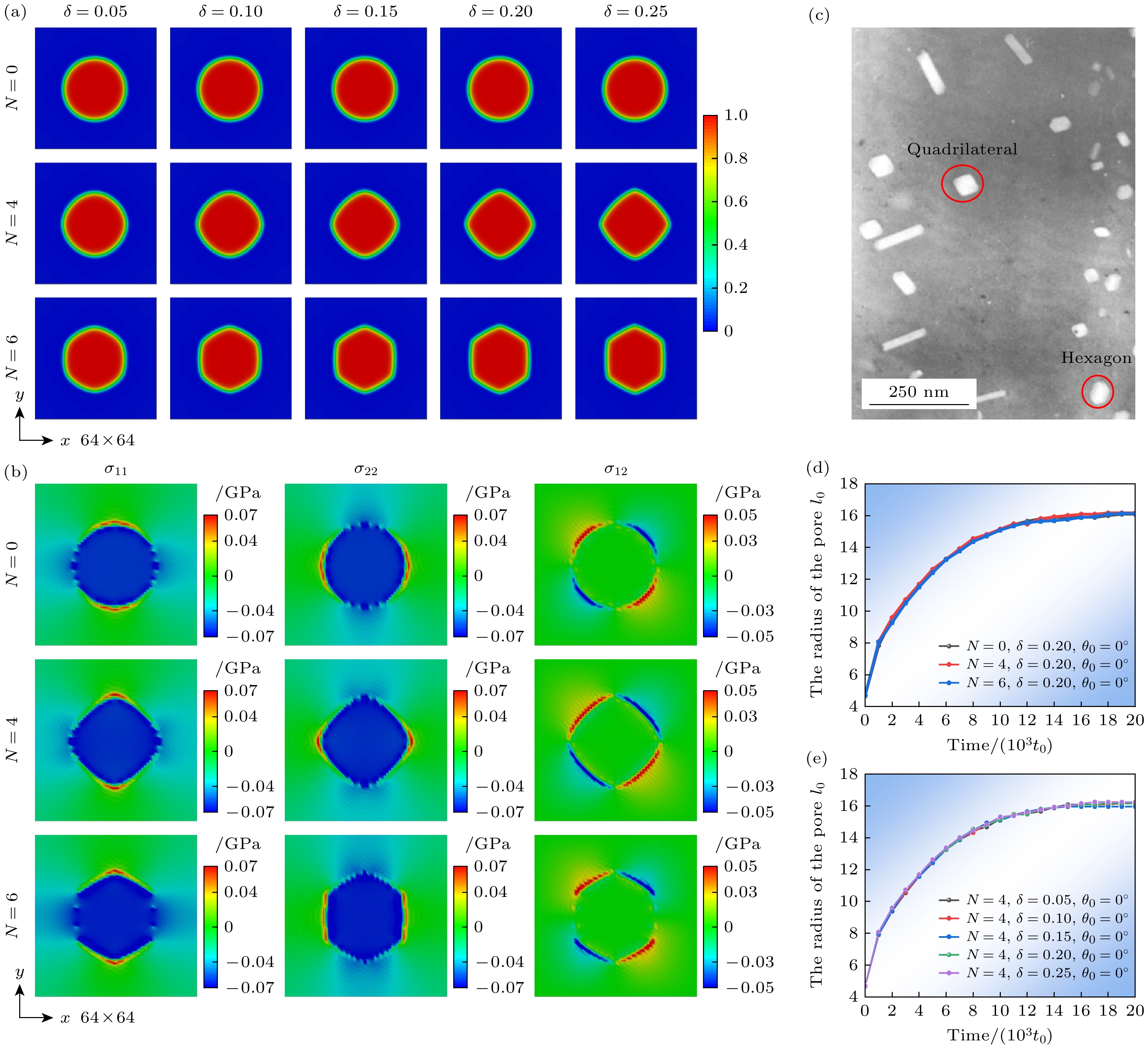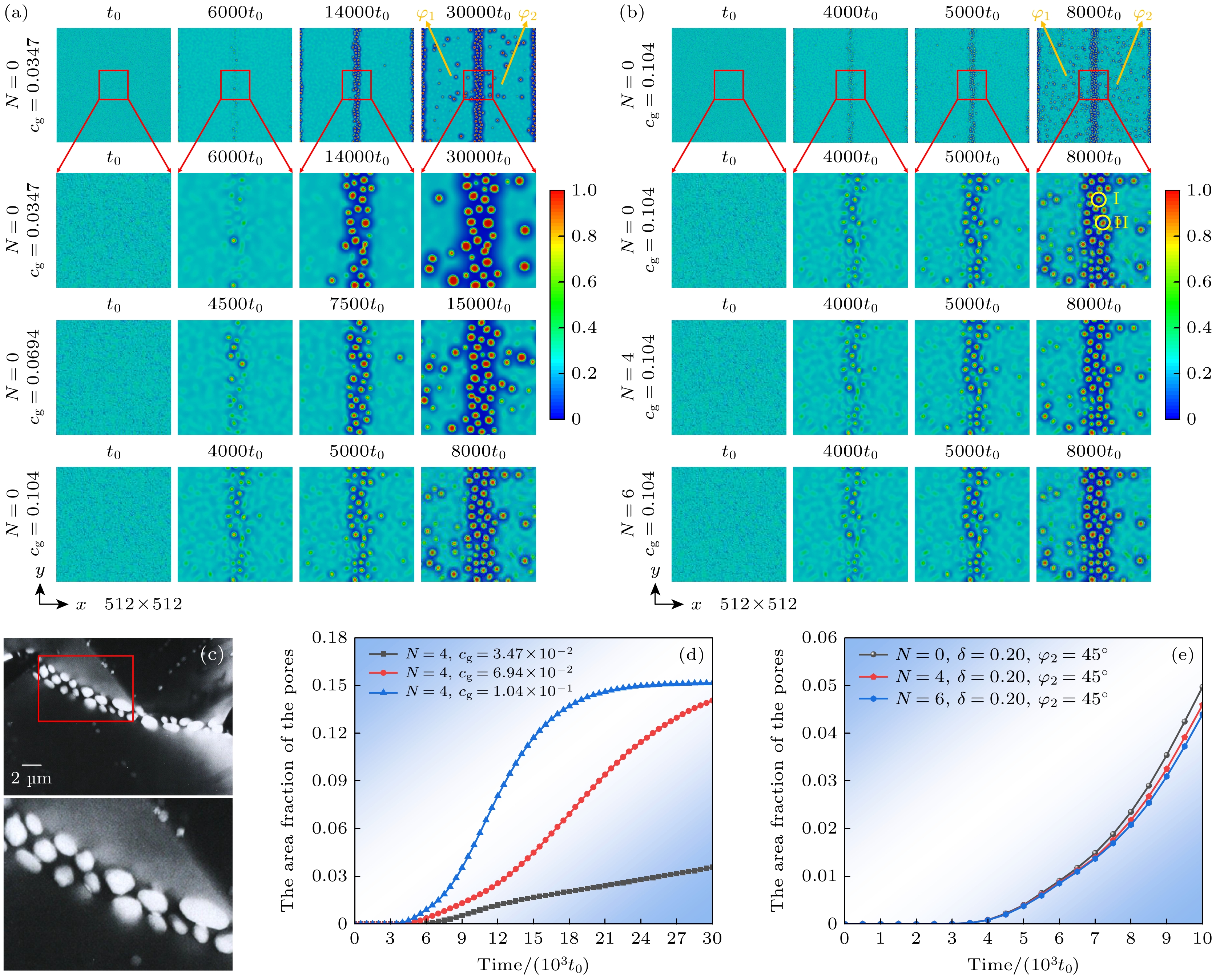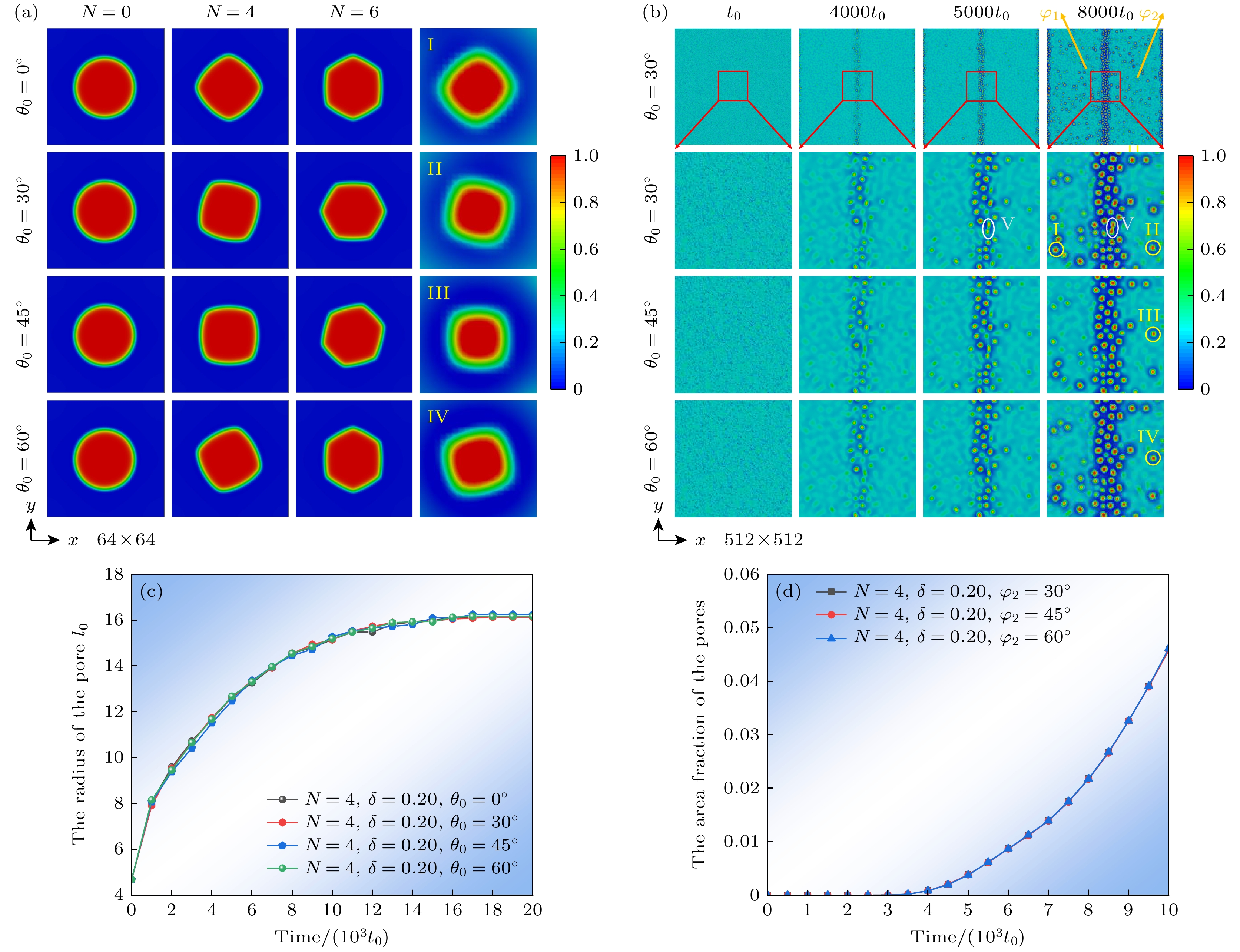-
奥氏体不锈钢或镍基合金等FCC构型的核反应堆堆芯结构件材料中易于观测到晶间孔隙或晶内各向异性孔隙. 孔隙内填充有少量气体, 其形貌与晶体表面各向异性有关, 又易于在晶界形核受晶界特性调控. 本文通过建立耦合晶面各向异性与孔隙-晶界交互作用的自由能泛函模拟孔隙及其形貌演化, 研究结果表明, He气体诱导孔隙形核, He气体浓度越高, 孔隙的孕育期越短, 形核越快, 长大速率越大. 晶界为孔隙形核提供非均质位点, 孔隙优先在晶界处形核长大, 形成沿晶析出的高密度弥散孔隙. 晶内孔隙呈各向异性特征, 受界面能各向异性模数、强度及晶体取向调控; 晶间高密度孔隙相互作用且受晶界影响, 各向异性形貌不显著, 位于晶界中间的孔隙近似呈现椭圆形. 本文的结果与实验结果符合得较好, 启发堆芯服役构件的寿命预测和堆芯材料设计.Intergranular or intragranular anisotropic pores can be easily observed in the FCC structure of nuclear reactor core structural materials, such as austenitic stainless steel or nickel-based alloys. Austenitic stainless steel contains a certain amount of nickel (Ni), and Ni undergoes transmutation reaction under neutron irradiation to produce helium. Helium combines with vacancy and continuously absorbs more helium and vacancy, evolving into under pressure pores filled with a small amount of helium. The morphology of pores is influenced by both the surface anisotropy of the crystal and grain boundary characteristic because pore nucleation predominantly occurs at grain boundary. The swelling effect caused by pores and the embrittlement effect of high temperature helium are related to the morphology, size and distribution of pores. The phase field method can couple multiple physical fields and accurately describe the effects of material microscopic defects on pores. In this study, we use the phase field method to simulate the evolution and morphology of pores, establishing a free energy functional coupling between crystal plane anisotropy and pore-grain boundary interactions. Our results demonstrate that helium gas induces pore nucleation, with higher concentrations leading to shorter incubation period, faster nucleation rate, and greater growth rate. Grain boundaries act as heterogeneous nucleation sites for helium pores, leading to the formation of pores along these boundaries and high-density diffusion pores within the grains. The intragranular pores exhibit anisotropic characteristics regulated by interfacial energy’s anisotropic modulus, the strength of the anisotropy, and crystal orientation. The high-density intergranular pores interact with each other significantly and are influenced by grain boundaries, while the anisotropic morphology is negligible. Additionally, it has been observed that the pores located in the middle of grain boundaries tend to become an elliptical. The stress inside the pores that contain a small amount of helium gas is negative, which is lower than the value in the matrix. These findings presented herein align well with experimental results, which inspires the prediction of service life of core components and the design of core materials.
-
Keywords:
- pores /
- anisotropic /
- phase field /
- irradiation
[1] 杨文斗 2000 反应堆材料学(北京: 原子能出版社) 第18—19页
Yang W D 2000 Reactor Materials Science (Beijing: Atomic Energy Press) pp18–19
[2] 杨辉, 冯泽华, 王贺然, 张云鹏, 陈铮, 信天缘, 宋小蓉, 吴璐, 张静 2021 70 054601
 Google Scholar
Google Scholar
Yang H, Feng Z H, Wang H R, Zhang Y P, Chen Z, Xin T Y, Song X R, Wu L, Zhang J 2021 Acta Phys. Sin. 70 054601
 Google Scholar
Google Scholar
[3] 刘彩艳, 冯泽华, 张云鹏, 余康, 吴璐, 马聪, 张静 2024 金属学报 60 1279
 Google Scholar
Google Scholar
Liu C Y, Feng Z H, Zhang Y P, Yu K, Wu L, Ma C, Zhang J 2024 Acta Metall. Sin. 60 1279
 Google Scholar
Google Scholar
[4] Wang H R, Yu K, Wang J C, Wu L, Zhang W, Zhang J 2024 Mech. Mater. 189 104865
 Google Scholar
Google Scholar
[5] Zinkle S J, Busby J T 2009 Mater. Today 12 12
 Google Scholar
Google Scholar
[6] Nazarov A V, Mikheev A A, Melnikov A P 2020 J. Nucl. Mater. 532 152067
 Google Scholar
Google Scholar
[7] Zinkle S J, Farrell K 1989 J. Nucl. Mater 168 262
 Google Scholar
Google Scholar
[8] Was G S 2017 Fundamentals of Radiation Materials Science: Metals and Alloys (New York: Springer) pp379–484
[9] Chen C W 1973 Phys. Status Solidi. A 16 197
 Google Scholar
Google Scholar
[10] Niwase K, Ezawa T, Tanabe T, Fujita F E 1988 J. Nucl. Mater. 160 229
 Google Scholar
Google Scholar
[11] Griffiths M, Styles R C, Woo C H, Phillipp F, Frank W 1994 J. Nucl. Mater 208 324
 Google Scholar
Google Scholar
[12] El-Atwani O, Hattar K, Hinks J A, Greaves G, Harilal S S, Hassanein A 2015 J. Nucl. Mater 458 216
 Google Scholar
Google Scholar
[13] Liu W B, Wang N, Ji Y Z, Song P C, Zhang C, Yang Z G, Chen L Q 2016 J. Nucl. Mater 479 316
 Google Scholar
Google Scholar
[14] Han G M, Wang H, Lin D Y, Zhu X Y, Hu S Y, Song H F 2017 Comp. Mater. Sci. 133 22
 Google Scholar
Google Scholar
[15] Vitos L, Ruban A V, Skriver H L, Kollár J 1998 Surf. Sci. 411 186
 Google Scholar
Google Scholar
[16] Tschopp M A, Solanki K N, Gao F, Sun X, Khaleel M A, Horstemeyer M F 2012 Phys. Rev. B 85 064108
 Google Scholar
Google Scholar
[17] Gao Z Y, Huang J, Liu H C, Ge W, Luo F P, Zhang B W, Liu G Y, Sun B R, Shen T D, Xue J M, Wang Y G, Wang C X 2023 Scripta Mater. 232 115497
 Google Scholar
Google Scholar
[18] Yan Z F, Yang T F, Lin Y R, Lu Y P, Su Y, Zinkle S J, Wang Y G 2020 J. Nucl. Mater. 532 152045
 Google Scholar
Google Scholar
[19] Hirth J P, Pond R C, Lothe J 2007 Acta Mater. 55 5428
 Google Scholar
Google Scholar
[20] Jiang Y B, Liu W B, Li W J, Sun Z Y, Xin Y, Chen P H, Yun D 2021 Comp. Mater. Sci. 188 110176
 Google Scholar
Google Scholar
[21] 戚晓勇, 柳何, 王恽 2023 金属学报 59 1513
 Google Scholar
Google Scholar
Qi X Y, Liu H, Wang Y 2023 Acta Metall. Sin. 59 1513
 Google Scholar
Google Scholar
[22] 刘续希, 柳文波, 李博岩, 贺新福, 杨朝曦, 恽迪 2022 金属学报 58 943
 Google Scholar
Google Scholar
Liu X X, Liu W B, Li B Y, He X F, Yang C X, Yun D 2022 Acta Metall. Sin. 58 943
 Google Scholar
Google Scholar
[23] Moladje G F B, Thuinet L, Becquart C S, Legris A 2022 Acta Mater. 225 117523
 Google Scholar
Google Scholar
[24] Sakaël C, Domain C, Ambard A, Thuinet L, Legris A 2023 Int. J. Plast. 168 103699
 Google Scholar
Google Scholar
[25] Liu C Y, Zhang Y P, Cheng D Z, Yu K, Teng C Q, Wu L, Zhang J 2024 Nucl. Eng. Des. 425 113321
 Google Scholar
Google Scholar
[26] Millett P C, El-Azab A, Wolf D 2011 Comp. Mater. Sci. 50 960
 Google Scholar
Google Scholar
[27] Bhattacharyya S, Heo T W, Chang K, Chen L Q 2011 Model. Simul. Mater. Sc. 19 035002
 Google Scholar
Google Scholar
[28] 姜彦博, 柳文波, 孙志鹏, 喇永孝, 恽迪 2022 71 026103
 Google Scholar
Google Scholar
Jiang Y B, Liu W B, Sun Z P, La Y X, Yun D 2022 Acta Phys. Sin. 71 026103
 Google Scholar
Google Scholar
[29] Greenwood M, Hoyt J J, Provatas N 2009 Acta Mater. 57 2613
 Google Scholar
Google Scholar
[30] Tonks M R, Zhang Y, Butterfield A, Bai X M 2015 Model. Simul. Mater. Sc. 23 045009
 Google Scholar
Google Scholar
[31] Golubov S I, Ovcharenko A M, Barashev A V, Singh B N 2001 Philos. Mag. 81 643
 Google Scholar
Google Scholar
[32] Russell K C 1971 Acta Mater. 19 753
 Google Scholar
Google Scholar
[33] Wen P, Tonks M R, Phillpot S R, Spearot D E 2022 Comp. Mater. Sci. 209 111392
 Google Scholar
Google Scholar
[34] Wang Y Y, Zhao J J, Ding J H, Zhao J J 2022 Int. J. Refract. Met. H. 105 105824
 Google Scholar
Google Scholar
[35] Lin Y R, Chen W Y, Tan L, Hoelzer D T, Yan Z, Hsieh C Y, Huang C W, Zinkle S J 2021 Acta Mater. 217 117165
 Google Scholar
Google Scholar
[36] Schroeder H, Kesternich W, Ullmaier H 1985 Fusion Eng. Des. 2 65
 Google Scholar
Google Scholar
-
图 1 不同各向异性模数N和不同各向异性强度$ \delta $情况下演化结果及实验观察到的各向异性孔隙 (a) 2.0×104t0时空位浓度场; (b) $ \delta $为0.2, 2.0×104t0时不同各向异性孔隙周围的应力场分布; (c) 辐照下奥氏体不锈钢中观察到的孔隙[8]; (d)不同各向异性模数N下孔隙半径随演化时间的变化曲线; (e)不同各向异性强度$ \delta $下孔隙半径随演化时间的变化曲线
Fig. 1. Evolution results under different anisotropic modulus N and anisotropic strength $ \delta $ and anisotropic pores observed experimentally: (a) 2.0×104t0 vacancy concentration field; (b) distribution of stress field around different anisotropic pores when $ \delta $ is 0.2 and time is 2.0×104t0; (c) the pores observed in irradiated austenitic stainless steel[8]; (d) variation curve of pore radius with evolution time under different anisotropy modulus N; (e) variation curve of pore radius with evolution time under different anisotropy intensities $ \delta $.
图 2 He气体浓度$ {c_{\text{g}}} $和各向异性模数N对孔隙的形核与长大的影响 (a) N为0, He气体浓度$ {c_{\text{g}}} $不同情况下孔隙的形核与长大; (b) He气体浓度$ {c_{\text{g}}} $为1.04×10–1, 各向异性模数N为0, 4和6情况下孔隙的形核与长大; (c) 实验中1023 K温度下辐照25 h的AISI 316 SS不锈钢中观测到的孔隙形貌[36]; (d) 不同He气体浓度$ {c_{\text{g}}} $下孔隙面积分数随时间的变化曲线; (e) 不同各向异性模数N下孔隙面积分数随时间的变化曲线
Fig. 2. Influence of He gas concentration $ {c_{\text{g}}} $ and anisotropy modulus N on pores nucleation and growth: (a) Pores nucleation and growth when N is 0 and He gas concentration $ {c_{\text{g}}} $is different; (b) pores nucleation and growth when He gas concentration $ {c_{\text{g}}} $ is 1.04×10–1 and anisotropy modulus N is 0, 4 and 6; (c) pores morphology was observed in AISI 316 SS stainless steel irradiated for 25 h at 1023 K temperature[36]; (d) variation curve of pore area fraction with time under different He gas concentration $ {c_{\text{g}}} $; (e) variation curve of pore area fraction with time under different anisotropy modulus N.
图 3 晶粒取向角$ {\theta _0} $对孔隙演化的影响 (a)晶粒取向角$ {\theta _0} $为0°, 30°, 45°和60°时晶内孔隙长大; (b)右侧晶粒${\varphi _2}$取向角$ {\theta _0} $为30°, 45°和60°时双晶体系中孔隙演化(图左侧标注$ {\theta _0} $为右侧晶粒${\varphi _2}$的取向角); (c)不同晶粒取向角$ {\theta _0} $情况下晶内孔隙半径随演化时间变化曲线; (d)右侧晶粒取向角不同时孔隙面积分数随演化时间变化曲线
Fig. 3. Effect of grain orientation angle $ {\theta _0} $ on pore evolution: (a) When the grain orientation angles are 0°, 30°, 45° and 60°, the intrachrystalline pores growth; (b) pores evolution in the twin-crystal system when the right grain orientation angle $ {\theta _0} $ is 30°, 45° and 60° (the left side of the figure is marked with the right grain orientation angle $ {\theta _0} $); (c) variation curve of the pores radius with evolution time under different grain orientation angles $ {\theta _0} $; (d) variation curve of the area fraction of pores with evolution time when the orientation angle of the right grain is different.
表 1 模型中采用的无量纲化参数
Table 1. Dimensionless parameters used in the model.
参数 值 参数 值 特征时间t0/s 5×10–3 空位迁移率$M_{\text{v}}^{\text{*}}$ 1 特征长度l0/nm 20 间隙原子迁移率$M_{\text{i}}^{\text{*}}$ 1 空位梯度系数$\kappa _{\text{v}}^{\text{*}}$ 1 He气体迁移率$M_{\text{g}}^{\text{*}}$ 2 间隙原子梯度系数$\kappa _{\text{i}}^{\text{*}}$ 1 He气体形成能$E_{\text{g}}^{\text{f}}$/eV 4[33] He气体扩散系数$\kappa _{\text{g}}^{\text{*}}$ 1 空位形成能$E_{\text{v}}^{\text{f}}$/eV 2[33] 表面能系数$\gamma _{_0}^*$ 1 间隙原子形成能$E_{\text{i}}^{\text{f}}$/eV 2[33] He气体化学势$\mu _{\text{g}}^{\circ}$/eV 0.4[26] 弹性模量$ C_{11}^0 $($ C_{1111}^0 $)/GPa 169[3] 相互作用系数$ {a_{\text{s}}} $ 1.1 弹性模量$ C_{12}^0 $($ C_{1122}^0 $)/GPa 131[3] 绝对温度T/K 710 弹性模量$ C_{44}^0 $($ C_{1212}^0 $)/GPa 84.5[3] 动力学系数${L^*}$ 1 -
[1] 杨文斗 2000 反应堆材料学(北京: 原子能出版社) 第18—19页
Yang W D 2000 Reactor Materials Science (Beijing: Atomic Energy Press) pp18–19
[2] 杨辉, 冯泽华, 王贺然, 张云鹏, 陈铮, 信天缘, 宋小蓉, 吴璐, 张静 2021 70 054601
 Google Scholar
Google Scholar
Yang H, Feng Z H, Wang H R, Zhang Y P, Chen Z, Xin T Y, Song X R, Wu L, Zhang J 2021 Acta Phys. Sin. 70 054601
 Google Scholar
Google Scholar
[3] 刘彩艳, 冯泽华, 张云鹏, 余康, 吴璐, 马聪, 张静 2024 金属学报 60 1279
 Google Scholar
Google Scholar
Liu C Y, Feng Z H, Zhang Y P, Yu K, Wu L, Ma C, Zhang J 2024 Acta Metall. Sin. 60 1279
 Google Scholar
Google Scholar
[4] Wang H R, Yu K, Wang J C, Wu L, Zhang W, Zhang J 2024 Mech. Mater. 189 104865
 Google Scholar
Google Scholar
[5] Zinkle S J, Busby J T 2009 Mater. Today 12 12
 Google Scholar
Google Scholar
[6] Nazarov A V, Mikheev A A, Melnikov A P 2020 J. Nucl. Mater. 532 152067
 Google Scholar
Google Scholar
[7] Zinkle S J, Farrell K 1989 J. Nucl. Mater 168 262
 Google Scholar
Google Scholar
[8] Was G S 2017 Fundamentals of Radiation Materials Science: Metals and Alloys (New York: Springer) pp379–484
[9] Chen C W 1973 Phys. Status Solidi. A 16 197
 Google Scholar
Google Scholar
[10] Niwase K, Ezawa T, Tanabe T, Fujita F E 1988 J. Nucl. Mater. 160 229
 Google Scholar
Google Scholar
[11] Griffiths M, Styles R C, Woo C H, Phillipp F, Frank W 1994 J. Nucl. Mater 208 324
 Google Scholar
Google Scholar
[12] El-Atwani O, Hattar K, Hinks J A, Greaves G, Harilal S S, Hassanein A 2015 J. Nucl. Mater 458 216
 Google Scholar
Google Scholar
[13] Liu W B, Wang N, Ji Y Z, Song P C, Zhang C, Yang Z G, Chen L Q 2016 J. Nucl. Mater 479 316
 Google Scholar
Google Scholar
[14] Han G M, Wang H, Lin D Y, Zhu X Y, Hu S Y, Song H F 2017 Comp. Mater. Sci. 133 22
 Google Scholar
Google Scholar
[15] Vitos L, Ruban A V, Skriver H L, Kollár J 1998 Surf. Sci. 411 186
 Google Scholar
Google Scholar
[16] Tschopp M A, Solanki K N, Gao F, Sun X, Khaleel M A, Horstemeyer M F 2012 Phys. Rev. B 85 064108
 Google Scholar
Google Scholar
[17] Gao Z Y, Huang J, Liu H C, Ge W, Luo F P, Zhang B W, Liu G Y, Sun B R, Shen T D, Xue J M, Wang Y G, Wang C X 2023 Scripta Mater. 232 115497
 Google Scholar
Google Scholar
[18] Yan Z F, Yang T F, Lin Y R, Lu Y P, Su Y, Zinkle S J, Wang Y G 2020 J. Nucl. Mater. 532 152045
 Google Scholar
Google Scholar
[19] Hirth J P, Pond R C, Lothe J 2007 Acta Mater. 55 5428
 Google Scholar
Google Scholar
[20] Jiang Y B, Liu W B, Li W J, Sun Z Y, Xin Y, Chen P H, Yun D 2021 Comp. Mater. Sci. 188 110176
 Google Scholar
Google Scholar
[21] 戚晓勇, 柳何, 王恽 2023 金属学报 59 1513
 Google Scholar
Google Scholar
Qi X Y, Liu H, Wang Y 2023 Acta Metall. Sin. 59 1513
 Google Scholar
Google Scholar
[22] 刘续希, 柳文波, 李博岩, 贺新福, 杨朝曦, 恽迪 2022 金属学报 58 943
 Google Scholar
Google Scholar
Liu X X, Liu W B, Li B Y, He X F, Yang C X, Yun D 2022 Acta Metall. Sin. 58 943
 Google Scholar
Google Scholar
[23] Moladje G F B, Thuinet L, Becquart C S, Legris A 2022 Acta Mater. 225 117523
 Google Scholar
Google Scholar
[24] Sakaël C, Domain C, Ambard A, Thuinet L, Legris A 2023 Int. J. Plast. 168 103699
 Google Scholar
Google Scholar
[25] Liu C Y, Zhang Y P, Cheng D Z, Yu K, Teng C Q, Wu L, Zhang J 2024 Nucl. Eng. Des. 425 113321
 Google Scholar
Google Scholar
[26] Millett P C, El-Azab A, Wolf D 2011 Comp. Mater. Sci. 50 960
 Google Scholar
Google Scholar
[27] Bhattacharyya S, Heo T W, Chang K, Chen L Q 2011 Model. Simul. Mater. Sc. 19 035002
 Google Scholar
Google Scholar
[28] 姜彦博, 柳文波, 孙志鹏, 喇永孝, 恽迪 2022 71 026103
 Google Scholar
Google Scholar
Jiang Y B, Liu W B, Sun Z P, La Y X, Yun D 2022 Acta Phys. Sin. 71 026103
 Google Scholar
Google Scholar
[29] Greenwood M, Hoyt J J, Provatas N 2009 Acta Mater. 57 2613
 Google Scholar
Google Scholar
[30] Tonks M R, Zhang Y, Butterfield A, Bai X M 2015 Model. Simul. Mater. Sc. 23 045009
 Google Scholar
Google Scholar
[31] Golubov S I, Ovcharenko A M, Barashev A V, Singh B N 2001 Philos. Mag. 81 643
 Google Scholar
Google Scholar
[32] Russell K C 1971 Acta Mater. 19 753
 Google Scholar
Google Scholar
[33] Wen P, Tonks M R, Phillpot S R, Spearot D E 2022 Comp. Mater. Sci. 209 111392
 Google Scholar
Google Scholar
[34] Wang Y Y, Zhao J J, Ding J H, Zhao J J 2022 Int. J. Refract. Met. H. 105 105824
 Google Scholar
Google Scholar
[35] Lin Y R, Chen W Y, Tan L, Hoelzer D T, Yan Z, Hsieh C Y, Huang C W, Zinkle S J 2021 Acta Mater. 217 117165
 Google Scholar
Google Scholar
[36] Schroeder H, Kesternich W, Ullmaier H 1985 Fusion Eng. Des. 2 65
 Google Scholar
Google Scholar
计量
- 文章访问数: 3006
- PDF下载量: 67
- 被引次数: 0














 下载:
下载:


